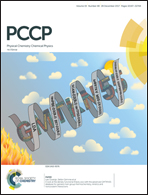How the hydrogen sorption properties of palladium are modified through interaction with iridium†
Abstract
Hydrogen sorption (adsorption/absorption) in metals, in the form of thin films or nanoparticles, is a key process in the fields of energy storage and heterogeneous catalysis. Atomic hydrogen dissolved in the subsurface of a metal affects its surface atomic and electronic structures, and thereby its surface reactivity and catalytic properties. In addition, alloy effects modify both catalytic and hydrogen sorption phenomena. In order to rationalize recent experimental results showing the negative impact of hydrogen absorption on catalysis, the present article proposes an insight into structure–reactivity relationships through computational simulations, using density functional theory, of hydrogen sorption in the near-surface region of palladium atomic layers interacting with an iridium substrate. A detailed analysis of the electronic structure using local projected densities of states (PDOS) and crystal orbital overlap population (COOP) curves was carried out. It is found that the Pd/Ir system, with respect to pure Pd surfaces, keeps acceptable adsorption properties for surface reactions while preventing hydrogen penetration. The results of electronic structure calculations show that the most important difference between Pd and Ir is related to the strong anti-bonding character of the 1s-H/5p-Ir interaction, leading to the non-bonding character of the sp-Ir interaction with hydrogen. Thus, increasing the Ir concentration in a Pd-based system increases the anti-bonding contribution, which strongly weakens the overall metal–hydrogen interaction.



 Please wait while we load your content...
Please wait while we load your content...